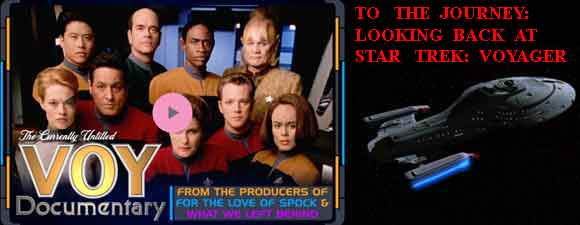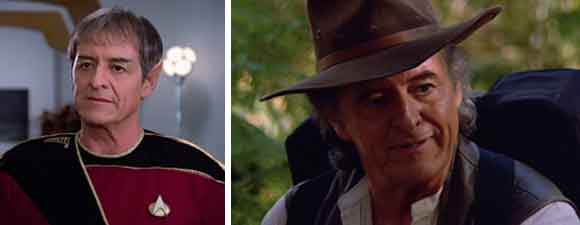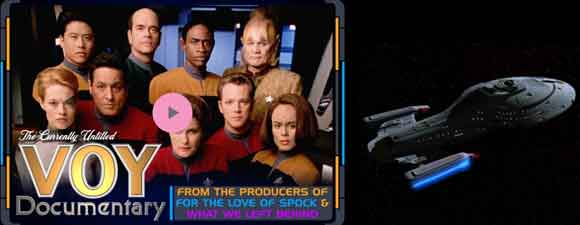Retro Review: Distant Origin
6 min read
distantoriginbanner
A scientist pursues Voyager in hopes of proving his theory that his species did not evolve in the Delta Quadrant, but came from elsewhere.
Plot Summary: Reptilian-looking Voth scientist Gegen and his assistant Veer examine the remains of Hogan, the Voyager crewman who died on Hanan IV. The Voth are thrilled to discover abundant evidence that humans are closely related to their species, which supports their theory of distant origin, which posits that their race did not evolve in the Delta Quadrant but arrived from elsewhere in the galaxy. Though Voth leaders warn the scientists not to challenge doctrine, Gegen and Veer attempt to trace the ship that brought the human to Hanan IV, ultimately tracking down Voyager and sneaking aboard using a cloaking device. The crew detects the cloaking signature and captures Veer while Gegen escapes, taking Chakotay with him as proof of the relationship between their species. The Doctor and Janeway examine Veer, concluding, like Gegen, that the Voth originally must have come from Earth, descended from dinosaurs and sharing a common ancestor with humans. When they try to reach Chakotay on Gegen’s ship, which is being pursued by Voth authorities, Voyager is captured by a Voth city ship. Not wanting the blood of Voyager’s crew on his hands, Gegen turns himself in. Though he initially refuses to recant the distant origin theory, which the Voth leaders warn may threaten their claim to their entire region of space, Gegen agrees to renounce his discoveries when told that if he refuses, the entire crew of Voyager will be sent to a penal colony while his and Veer’s families will suffer. Before Voyager leaves Voth space, Chakotay gives Gegen a replica of Earth so that he will remember where he really comes from and what he stands for.
Analysis: In the years since it first aired, I’ve found that people either adore “Distant Origin” or cite it as an example of everything that’s wrong with Voyager or indeed with Star Trek. I’m not a paleontologist now and I certainly wasn’t twenty years ago, so I hesitate to delve too deeply into their scientific objections. Our understanding of dinosaurs has developed markedly in the past couple of decades – for one thing, we know that they weren’t all cold-blooded – and while it’s relatively easy to forgive the show for its outdated sense of dinosaur biology and facile models of how evolution works, it’s harder to get over the initial eye-rolling at the idea that dinosaurs 1) built a mighty civilization on a continent of which no trace remains, 2) launched themselves into space without leaving behind any evidence of their scientific prowess which presumably would have touched land masses and planets other than our own, and 3) somehow wound up in the Delta Quadrant yet never came across Chakotay’s ancestors from “Tattoo,” the Briori who brought “The 37s,” or those inferior mammalian humanoids the Borg. Those are a lot of facile coincidences to ask an audience to accept, so I don’t fault people who find it all too ridiculous to swallow, even though it’s in the fine original series tradition that gave us “Bread and Circuses,” “Patterns of Force,” and “Return to Tomorrow.” If we’re going to accept Star Trek’s initial premise that bipedal, mammalian humanoids evolved all over the galaxy and created languages similar enough in structure for a Universal Translator to work nearly all the time, dinosaurs in space aren’t such a big stretch. This is, after all, the series which postulated that humans traveling at Warp 10 will turn into giant salamanders.
“Distant Origin” thus may not be solid science fiction like the original series’ “Devil in the Dark,” nor an exceptional character story like Next Gen‘s “The Measure of a Man,” and it’s not a powerful political allegory like Deep Space Nine‘s “Duet,” but a lot of elements come together to make it enjoyable and memorable. Janeway has a terrific outing as both a captain and a scientist, though she’s outmatched by the technology of the dinosaurs and it’s a shame she doesn’t get to discuss their transwarp capabilities before Voyager has to rush away. This is also the only episode I can think of in which Chakotay gets to make a Kirk-like speech about how eyes are opened – an important metaphor for the Voth – when new ideas challenge received wisdom, and he acquits himself very well, though I wish he’d made it a bit more personal, talking about his own relationship to his people’s myths and how they were adapted to take in both scientific developments and a painful history of conquest. As with Kar of the Kazon, Chakotay and Gegen form an enduring bond despite the fact that they meet under adversarial circumstances that cause friction between the alien and his closest allies. Chakotay doesn’t manage to persuade the T’Pau-like Minister Odala to transform Voth society overnight as Kirk probably would have, but he isn’t a demagogue like Kirk – he respects her people’s traditions – and she’s a fascinating character. One doesn’t get the impression that the leader’s deeply held beliefs are being challenged on a private level, but a pragmatic one. She’s not a religious ideologue; she’s a politician who’d prefer not to have to use threats to maintain the status quo, yet proves adept at guessing exactly what will make her opposition buckle to her demands. The truth is irrelevant to her.
The Voth leadership thus represents an obvious parallel to both conservative politicians who align with Creationists and countries that justify colonialism by rewriting regional history. If the speeches about doctrine sound a little didactic, they also seem more relevant than ever after twenty additional years of human leaders denying climate change. Too bad we don’t get to see more of Voth society, particularly since the aliens identify Voyager as a matriarchy as recognize flirting behavior among smelly mammals. I know there are a lot of Paris/Torres fans who enjoy their courtship, but once again I’m finding their cliched banter tiresome, and it’s particularly irksome when a genius engineer is being second-guessed by a Starfleet slacker – whether we’re supposed to believe Tom is genuinely more clever about B’Elanna on a technical question or whether we’re supposed to assume she’s playing dumb to lose their bet on purpose, it’s out of character and makes me wince. Still, it’s always interesting to see familiar characters and scenarios from the point of view of outsiders, so what a wonderful device to start “Distant Origin” from the distant perspective of two aliens studying Hogan’s bones and uniform, not even spotting Voyager and its crew until more than a quarter of the episode had passed. How fun to see the crew as the aliens being examined by a species that considers itself a higher life form! And how much more fun when the tables are turned, when we see Janeway’s crew competently expose the invaders who suddenly seem inarticulate and helpless, unable to make themselves understood. Long before they know they’re dealing with long-lost cousins, the crew displays the best of Starfleet attributes in responding not with anger but attempts to understand.






